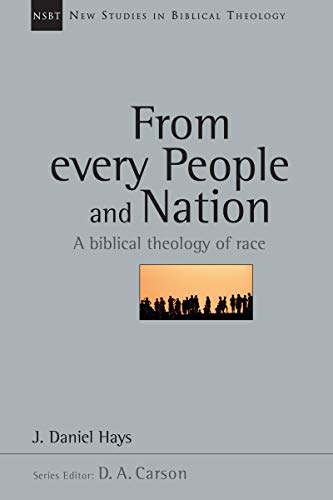An Author Interview from Books At a Glance
Would you like to watch the video interview or listen to the audio? Sign-up today for access to these features and more.
I don’t know when the issues of race and race relations has more dominated American discussion, and now if ever a biblical understanding of the issues is needed.
Greetings, I’m Fred Zaspel, and welcome to another Author Interview here at Books At a Glance. Today we’re talking to Dr. J. Daniel Hays about his nearly one-of-a-kind book, From Every People and Nation: A Biblical Theology of Race – volume 14 in IVP’s excellent New Studies in Biblical Theology series.
Dan, welcome – great to have you on Books At a Glance.
Hays:
Great to be with you, Fred.
Zaspel:
First, tell us just in brief what your book is all about and what you hope to accomplish with it.
Hays:
Years ago, we had an African American pastor, an alumnus of our school, on campus and he was talking about some issues of race and the Bible. Chatting with him after his chapel lecture, we were talking about the nation of Cush, an African nation. He invited me to a conference on the Cushite’s.
I assumed I could gather the information quickly and make that presentation. As I started studying and looking at it, I was stunned on two fronts. One, I found that the Cushite’s show up throughout the Bible. Two, there is a tremendous amount of information on them. I was shocked of why we are not hearing more about the nation. As that started shaping up, I realized there are a lot of helpful things in the Bible that it addresses on Cush. Not only the role that black African’s are playing in the biblical story but the implications for us with racial tension. I start off by talking about the ethnic layout and world of the Old Testament. If you grew up in a white church, you kind of assumed everyone in the Bible looks like you. But it is a multi-ethnic world.
I work through the Bible, starting in Genesis. First, everyone is made in the image of God. Then the scattering of ethnic groups plays a role and how God’s promise to Abraham brings us back together in Genesis 12. I point out that these Cushite’s show up and they are black Africans from this region south of Egypt. What are the implications of this? Moses marries a Cushite. This has implications for our concepts of inter-racial marriage.
On into the New Testament, we see in the Gospels, the reaching out to the Samaritans. This is a cross of racial lines in the New Testament from Jerusalem, to Judea, and to Samaria. The Ethiopian eunuch in Acts is from the region of Cush. He is the first Gentile represented in the Gentile inclusion. Then Paul will discuss that our identity is not an ethnic identity, but our identity is in Christ. We are all apart of the same family. In Revelation, they pick back up on these terms from Genesis 10. Everyone is from every tribe, tongue, and nation. My goal was to popularize this and help Christians to know what the Bible tells us about race. I am trying to inform on that.
Zaspel:
What is ethnicity, and how is ethnicity determined?
Hays:
I prefer the term ethnicity over race. Race is very misused. It is a sociologically accurate kind of term. What ethnicity is dealing with is trying to define what the social boundaries are that different groups of people create. People naturally pour into groups and establish them with some sort of social boundaries.
Boundaries can be a range of things, skin color, appearance, facial features. It also applies to other things like language, religion, the way you dress, the region you live in, your common history of ancestry. These kinds of things help us understand ethnic groupings. In different countries they may look the same to us, but they clearly have different tribes and boundaries.
Zaspel:
What are the ethnic categories in view in your book? And who are these various people groups as they are named in the Old Testament?
Hays:
If you look at the ancient Egyptians, they have a lot of literature. From the biblical times we have a lot of their literature and artwork. They have painted all kinds of depictions and scenes in their ancient tombs. I start with how the Egyptians view the world. They put things into categories as far as people groupings. You see them depicted with how they paint these people as well. They show themselves first. Then they describe the Libyan’s who live to the West of them. They have the Cushite’s, black Africans, to the South of them. Then they depict the, Asiatics, to the North. These are the Semitic peoples that would represent the Israelites and Canaanites. They depict the Philistines that invade Canaan and Egypt. And they depict the Hittites. One thing that comes into play is that the Cushite’s are called Ethiopians by the Greeks. In the Asiatic languages they are called the Cushite’s.
Zaspel:
I’ll ask you to explain the curse on Ham (Gen. 9) in a moment, but for now just more broadly – explain for us the importance of Genesis 1-12 in this discussion.
Hays:
What is fascinating is those opening two chapters where all people are created in the image of God. Everyone has this equal value being created in the image of God. We see the story move along in Genesis 11 at the tower of Babel. Genesis 10 is the result of what happens in 11. They are now scattered into languages, tribes, and regions. We have the problem of rebellion and Genesis 12 starts the great story of redemption with Abraham. God makes his promise to Abraham he promises land, descendants, and blessings. God promises to bring all these groups back together. Paul talks about how we are now the seed of Abraham, and all people are brought into this family by faith. Genesis 1-11 sets the stage and Genesis 12 shows how we are going to be brought back to this people by faith.
Zaspel:
Talk to us about the famous “curse on Ham” – Canaan, actually – and how it has been variously understood. Just what was the offense? What is – and what is not – the meaning of the curse? And how was it fulfilled?
Hays:
After the flood, Noah gets drunk and is laying in his tent naked. Ham sees him and does not do anything. He tells his brothers and they politely and respectfully cover their father. We are not 100 percent sure what is going on culturally what is going in the offense, but it seems to be serious. Noah wakes up and says, “cursed be Canaan.” We are told that Ham is the father of Canaan. We know the Old Testament and we know the Canaanites are the enemies of Israel throughout the coming books. The Canaanites being cursed is a prediction that they will be subdued in times to come. That is fulfilled as we get into the books of Joshua and Judges.
This was misinterpreted when people tried to come up with a biblical justification for slavery. They did some wild hermeneutical exegesis here. They assumed that Ham somehow means the black races. Now they are cursing Ham’s descendants and fulfilling the prophecy if they enslave his descendants. You cannot just take the name and say it means black. The curse is not on Ham anyway. The curse is on Canaan. Ethnically the Canaanites are ethnic cousins of the Hebrews. As far as those ethnic boundaries, they are very close in language and other things. This curse is clearly not an ethnic thing. The major difference between the Israelites and Canaanites is the God they worship. This is a religious thing not an ethnic thing.
Zaspel:
How are questions of race relations treated in the New Testament.
Hays:
Starting with the Gospels, Jesus has a lot to say about the Samaritans. We realize if we look not only from the New Testament but at other ancient sources, that the Jews and Samaritans did not get along. Jesus brings up their ethnic tensions all the time. In the book of Acts, the Samaritans are brought back in, and the Ethiopian eunuch is brought in, all of Jerusalem is turned against the Gospel but these other ethnicities are brought in.
Paul tells us there is no Jew or Gentile. If you take those boundary issues of how you look, talk, dress, or believe, Paul describes the new Christian with all these new terms. We are now descendants of Abraham. He says to put on Christ and be like Christ. He is uniting everyone together in Christ. This is helpful as we deal with racial tensions, especially with other Christians. Paul refuses to let the church split upon ethnic lines.
Zaspel:
Is Pentecost significant in all this?
Hays:
Yes, it is the pouring out of the Spirit, and we get the new covenant. All these different groups are coming to Jerusalem and speaking all these different languages. It is a very multi-ethnic experience. Also, it connects all the way back to Genesis 10 again with what you see taking place at Pentecost.
Zaspel:
Before I let you go, give us a brief overview of your book.
Hays:
Basically, in this book from every people and nation I want to give Christians a view of what the Bible says about race. I present different Scriptures there and show how this should inform us about race. There is an important role that black-Africans play in the Bible. They were not added late in church history but were there from the beginning. All were created in the image of God and the New Testament mandate for us is to see our identity in Christ through all these different ethnicities together.
Zaspel:
We’re talking to Dr. Danny Hays about his excellent book, From Every People and Nation: A Biblical Theology of Race. It’s an excellent biblical study of a topic more relevant it seems every day, and you’ll enjoy learning from it.
Dan, thanks so much for your good work and for talking to us today.
Hays:
Great to be with you, Fred. Thanks for having me on the show.

